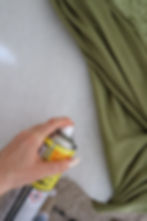well that's a title - basically its a mix of the diy headboard and the cardboard roll side table cause I had leftover from both.


Need:
- a piece of wood or MDF as the base
- cardboard tubes or wooden legs
- padding (mine is 5 cm thick)
- fabric that is sort of stretchy
- spray adhesive
- staple gun
- jigsaw to cut your wood
- handsaw to cut the legs

first and foremost
tbh I skipped taking pics of the first steps, if you want pictures check out the headboard blog post.
cut your wood into your desired shape and use it as a template to cut your padding in a matching shape. I used two layers of padding in this case for extra super plush feel.
glue the two layers of padding with the spray adhesive together, same with the wood base, spray it with the adhesive and glue the two layers of padding on top.

no to wrinkled fabrics
next spray the top of the padding with adhesive and glue your fabric on, make sure you don't get wrinkles. don't go too heavy on the glue, to prevent it from seeping through.
cut your excess fabric but leave about 10 cm on each side extra to have enough working fabric for the stapling part.

flip it
turn your top part upside down and put in on the floor to have a stable underground for the stapler.

more staples - more staples
start to staple the fabric onto your wood backing starting at one edge. pull lightly, but not super crazy, since the fabric is a bit stretchy. work your way around the whole piece.

snatch the curve
I feel its easiest to do the biggest curves first and then work your way around, this way you don't pull it too much and totally relocate your padding underneath.
depending on your shape the curves can be a bit tricky. starting at the 'valley and working your way to the top is easiest I feel.

LEEEEEGGGGSSSS
once you've stapled everything in place, start with your legs. I decided on the cardboard tubes because I had them at home. I cut one in half to get a low stool.
depening on what you wanna use it for, go with two or four legs of your desired height. you can totally just do a padded top with some cool furniture legs like pin needle legs, what ever you fancy.
I like me my cardboard tube.

plush leg who
I decided to cover the cardboard in the same fabric for an over all plush look. Spray the tube with adhesive and roll it with some extra at the top and bottom onto the fabric, again mind the wrinkles

neat leg tho
once covered cut the excess fabric leaving extra to make it look neat.

nice tuck
I went around the whole leg and stapled the heck outta this thing to have a nice and clean edge.
I did this on both sides and tucked the leftover into the tube.

burrito flap wrap
to get rid of the raw edge I tucked it into the extra fabric and folded it over to be hidden.


I secured the flap with staples as well for extra durability

the glue - yes the glue
I hear ppl scream already, yes I glued the legs on. since MDF is superb to glue as well as cardboard I just did it. the glue seeps through the fabric into the cardboard and the MDF. I used contact glue wich means you put glue on both sides let it cure to get tacky and then you press both sides together, this way you get a super stable connection.
thats to the glue. If you use other feet that need screws, screw them to the bottom (make sure your wood base has a decent thickness) or screw them on before you glue the padding onto the wood and screw them in from up top.

I pressed the glue over night and boy they are stuck on there, super stable.











































